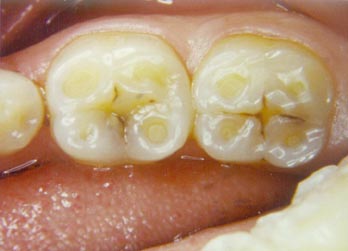Additionally, bruxism (name for the condition of grinding teeth) may lead to your jaw feeling stiff, teeth becoming sensitive to cold, and jaws being tired after a night’s rest. Without diagnosis and immediate intervention of this condition, several things can occur:
- Teeth become extremely sensitive to cold liquids and food.
- Compromise of existing fillings and crowns because these restorations are not strong enough to counter the impressive strength of our muscles and teeth.
- Increase risk of cavities. The more yellow surface of the tooth showing through is dentin. Unfortunately, dentin is not nearly as strong and cavity resistant as our outer enamel.
- Additionally, the teeth become shortened and flat. (see below)
In either event, please consult with your dentist. He/she will be able to assess the potential causes of your bruxism and develop a treatment that would cater to your unique case. Upcoming articles, I will be going more in depth on two possible treatments: night guards and braces (traditional and Invisalign).
While dimples are excellent on golf balls and babies, let’s keep them away from your teeth!
Happy golfing,
Dr. Lynda Tran
Golf Ball Anatomy: Golf balls with dimples are able to achieve “truer” flight than those that are smooth. While most dimples on golf balls are circular, it is believed that hexagonal dimples provide balls more lift.



No comments:
Post a Comment